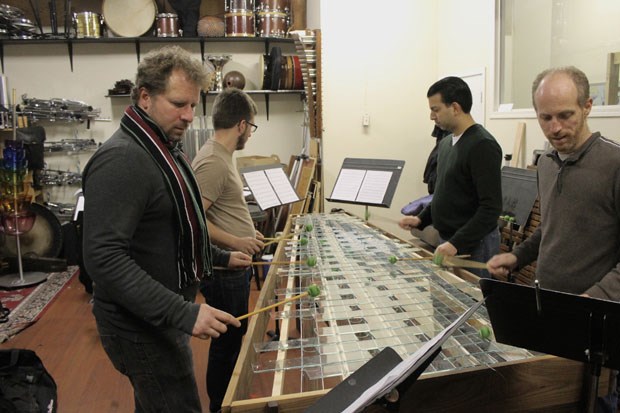City of Water, Sea of Glass, an original performance installation featuring blown-glass instruments, Friday, Jan. 29 at 8 p.m. at Erickson’s Waterfall Building Gallery, 205 - 1540 West Second Ave., Vancouver. Tickets: brownpapertickets.com.
A group of B.C. glassblowers and musical composers have collaborated to elevate an ancient science experiment involving water and glass to harmonious levels.
North Vancouver-based Redshift Music Society has teamed up with This Is It Design in Roberts Creek to curate an original performance installation to be unveiled on Jan. 29 that intersects art and music: City of Water, Sea of Glass.
Sticking to its mandate to produce unique concerts in unconventional spaces, this time around Redshift wanted to showcase Vancouver’s Waterfall Building Gallery — with its Louvre-like sloping glass walls.
“It’s a unique open space, it’s ambient and beautiful architecturally,” says Redshift artistic director Jordan Nobles. “We have a lot of beautiful architecture in this city and we like to exploit it.”
Redshift has often capitalized on the reverberant atrium of the Vancouver Public Library by spreading musicians throughout seven levels, creating a unique, captivating soundscape.
To commemorate the 100th anniversary of the Titanic sinking, in 2012, Redshift put on a concert at the Vancouver Aquatic Centre that featured musicians perched on the dive tower while people swam below.
For its latest performance, taking the theme water and glass, Redshift staff started with the art first. They approached two B.C.-based glassblowers and sculptors, Heather Konschuh and Robert Studer, to create strikingly original percussion instruments made of water and glass.
Nobles says it was a trial and error experiment, watching the artists blow glass and then working with them to create cool sounds. Plenty of glass was broken was in the process, he reveals.
“Wouldn’t it be cool if we had a gong that was glass? Apparently not,” says Nobles, with a laugh.
Almost everyone has heard the reverberant sound of musical glasses, created by rubbing fingers on the rims, a phenomenon that dates back to Renaissance times. This goes beyond that.
There are “tons of other sounds that you can make” with water and glass, explains Nobles. Imagine the sound of coins dropping into cavernous glass bowls, or water being strained to emulates a serious rainfall.
B.C.-based composers Benton Roark, Nova Pon, Chris Reiche, Christiaan Venter and Mariah Mennie were given free rein to create music for water or glass instruments or a combination of both. Those pieces will be premiered during City of Water, Sea of Glass, by the Vancouver-based Fringe Percussion quartet playing the specially crafted glass instruments.
The new percussion instruments created by the glass sculptors include the Chromarimba, a three-octave marimba with 31 tones per octave and keys of glass; the Rainbow, a six-inch-tall tree that holds seven bowls of blown glass in gradually tapering sizes; and Glass Bowl-Gongs, featuring five suspended, inverted bowl-gongs fashioned from blown glass.
North Vancouver resident Daniel Tones, who plays in the Fringe Percussion Quartet, says the performance is ultimately about the connection between sound, sculpture and space.
“It’s not every day that a musician has the opportunity to play brand new instruments that are themselves works of art,” said Tones. “Musicians and visual artists collaborating like this is an amazing expression of creativity and culture.”
The evening culminates with the Vancouver premiere of “Water Music,” a virtuoso quartet for amplified water bowls penned by renowned Chinese composer Tan Dun, who composed the score for Crouching Tiger, Hidden Dragon, and for the 2008 Beijing Olympics. Redshift rented an assortment of “rare and beautiful” instruments from Dun for the performance.
“Musicians get quite wet during the piece, splashing and being percussive with the instruments,” says Nobles.
City of Water, Sea of Glass curators hope the performance and use of the organic elements will connect people to their urban soundscapes, “which is particularly important during the dark, wet winter months when loneliness can seep into the collective consciousness.”
January was specifically chosen for the event because it “is a great time for rain.” Judging by Friday’s forecast there should an adequate amount of rain to cascade down the glass walls of the Waterfall Building and add to the ambience of the event.
“We couldn’t do this show in the summer,” laughs Nobles.



